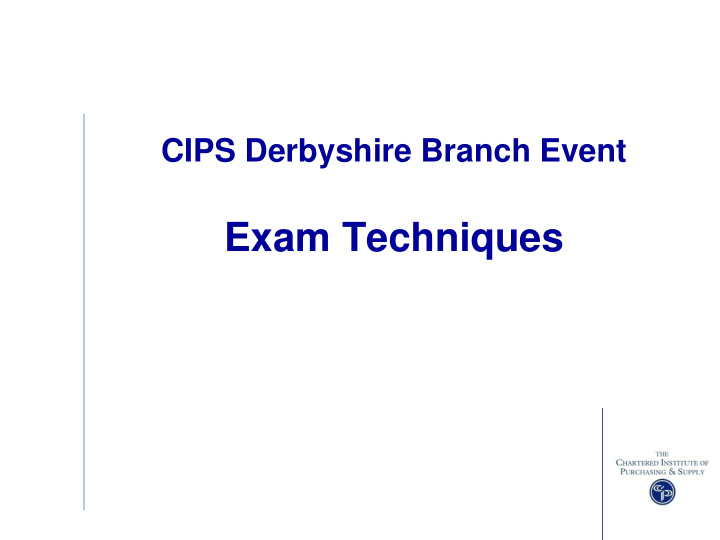



CIPS Derbyshire Branch Event Exam Techniques
Structure of the Session Examination Shortcomings Examination Techniques
Common Examination Shortcomings
Common exam shortcomings ? What do you think are the most common mistakes in examinations?
Examination Shortcomings 1. Not using the case 2.Ignoring command words material in section A 3.Poor time management 8.Nerves Failure to Gain a Pass Mark 4.Answering outside the syllabus 7. Poor structure 6.Not answering the 5.Lack of exam question set preparation
Common exam shortcomings- Cont Students: • Misinterpret the question • Put the wrong question number on their script • Answer the question they would liked to have seen • Provide a theory dump without application • Cite the name of the wrong theorist • Don’t answer in the format requested • Omit own or company examples • Waffle – go off on a tangent from the question • Run out of time/don’t answer enough questions
How to Improve at Examinations Yes you can learn to pass exams !
Structure of this Section Pre Exam Planning Studying Revision Logistics During the exam Answering case studies Command words / understand the question Planning & structuring the answer
Planning for the Examination Studying Attend all workshops of the programme or study regularly Remember that the examination is based on the syllabus not Profex or the CIPS study guide Purchase and read the study guide Open the cellophane of Supply Management! Start revision early enough Practices mock papers/examination questions
Planning for the Examination Revision Revise your notes and handouts from workshops Recall work experiences and/or company examples that you can list against the syllabus Be confident with command words Learn some appropriate theories you can use in the exam
Planning for the Examination Logistics • Ensure you have checked the time, date & venue of the examination • Know your travel route • Allow plenty of time to reach the destination • Arrive at least 15 minutes in advance of exam start • Don’t cram in revision at the last minute • Get a good night’s sleep and have some breakfast • Take appropriate resources i.e. CIPS registration document, pens, pencils and a calculator
During the examination • Spend adequate time on the case in section A • Read the questions carefully • Highlight the command words in the question • Write brief notes at the top of each answer to tick off as you cover each point • Spread your time evenly over the examination – i.e. 3 hrs = 1.5 hours for both Section A & B • Reply in the format requested – i.e. Report or briefing notes etc
Dealing with Case Studies CIPS recommends a minimum of 30mins reading time per case study at levels 3 to 6 Good idea to read the case at least twice – highlighting the key issues. Think about: Context Key issues – prioritise Main point with ref to the unit content What assumptions have been made
Answering Case Studies Remember to answer in the context asked in the questions – for example do you have to assume a role. What format is the answer required in for example informal report (note there is up to two marks per question for answering in the correct format). Refer to the case study issues as part of your answer – don't be too general. Remember as the levels increase then you will be expected to apply your knowledge in more depth to the case – all the answer won’t be in the case wider considerations may be required.
Time Management It is important that you answer all the questions that you have to. ‘Time has already been allocated for you to read the case study (30 minutes) and a further 10 minutes has been suggested as recommended question reading time. Hence, the time you have available to prepare and answer the four exam questions is around 2 hours and 20 minutes. This gives you 35 minutes to spend on each question.’ ( source Examination Techniques: a guide for students – CIPS Nov 07)
Understanding the Question 2. What aspect 3. What of the topic is 1. Identify the Command being asked relevant topic word is being for? used? QUESTION Question 4. Is anything 5. How many 6.What format else required ? marks? is required? e.g. examples
Test Apply the previous exercise to the questions below from L4 Developing Contracts (July 2011) Explain with examples, the differences between a condition and a warranty in a contract (10 Marks)
Answer Step 1 – Topic is terms of contacts. Step 2 – The aspect is the difference between conditions and warranties Step 3 – Command word – Explain Step 4 – Anything else – yes examples required. Step 5 – marks 10 – not as detailed answer as a 25 mark question Step 6 – Format - Essay
Planning the Answer Step 1 Plan Step 2 Write Review
Structure of the Answer • Don’t theory dump or answer the question you would have liked to have seen • Avoid lists!! • Structure your answer - most questions require: - An introduction - Main body - Conclusions/Recommendations • Make one strong point in each paragraph
During the examination Keep checking that you are answering the question If you have time – read through all your answers at the end Don’t PANIC! Final thought PREPARATION, PREPARATION, PREPARATION = CONFIDENCE
Further Information The CIPS Examination Techniques Guide is available from: www.cips.org/studyandqualify/studyresources/study support
Recommend
More recommend